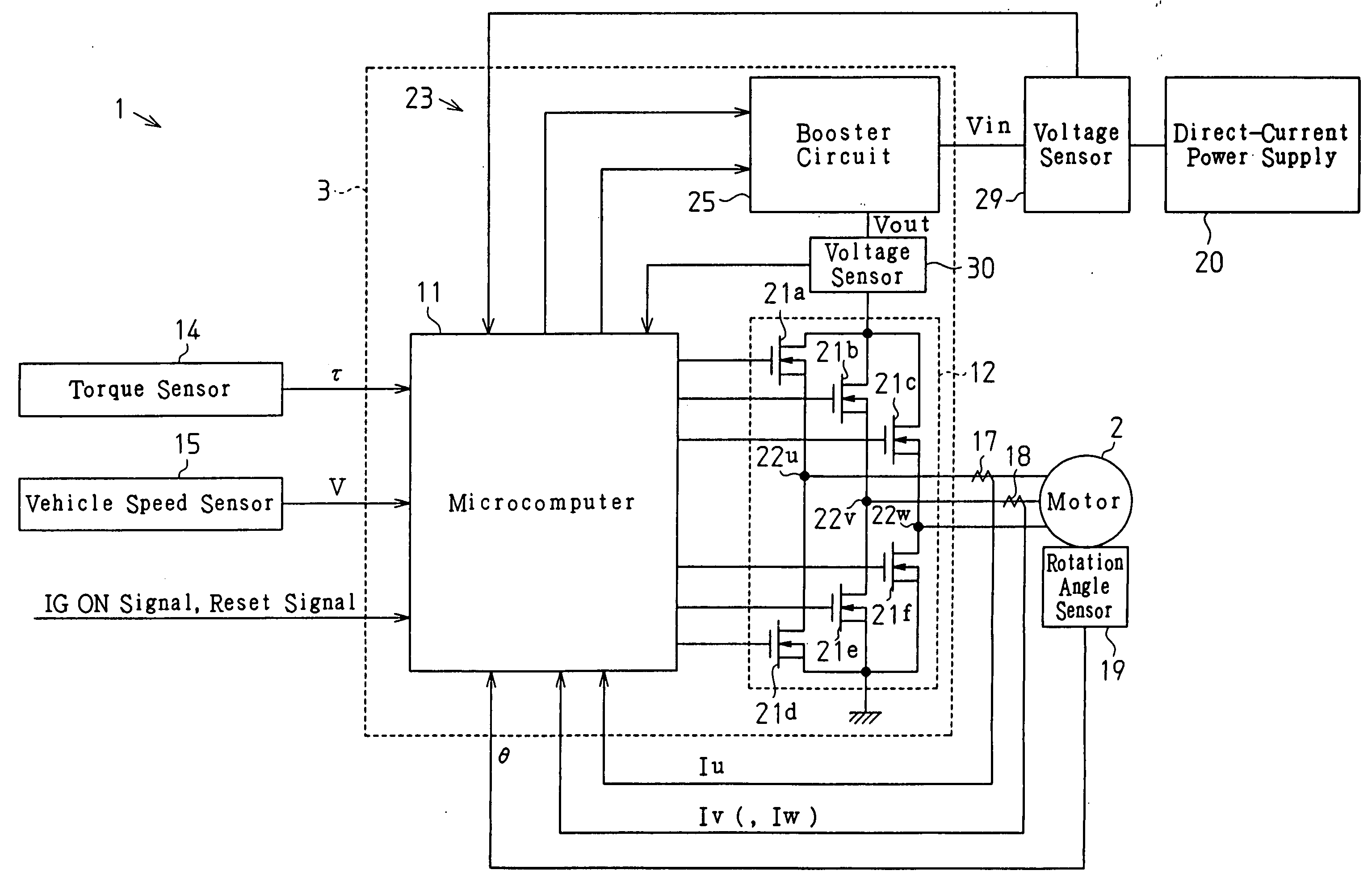Booster
- Summary
- Abstract
- Description
- Claims
- Application Information
AI Technical Summary
Benefits of technology
Problems solved by technology
Method used
Image
Examples
first embodiment
[0037] Hereafter, an electric power steering (EPS) apparatus 1 having a booster 23 according to the present invention will be described with reference to the drawings.
[0038] As shown in FIG. 1, the apparatus 1 includes a motor 2, which functions as a driving source for applying assisting force to the steering system of a vehicle, and an ECU 3 for controlling the motor 2.
[0039] A steering wheel 4 is coupled to a rack 6 with a steering shaft 5. Rotation of the steering shaft 5 caused by steering operation is converted into linear reciprocation of the rack 6 by means of a rack-and-pinion mechanism (not shown) and is transmitted to steered wheels 8. The EPS apparatus 1 of this embodiment is a rack type EPS apparatus, in which the motor 2 is arranged coaxial with the rack 6. Assisting torque generated by the motor 2 is transmitted to the rack 6 through a ball screw mechanism (not shown). The ECU 3 controls assisting force applied to the steering system by controlling the assisting torqu...
second embodiment
[0108] in the predetermined period T that corresponds to the period of the initial state, the duty ratio guarding coefficient Gd monotonously (proportionally) increases from 0 to 1.0 on the duty ratio guarding coefficient map 42a as the elapsed time t increases. At the initial state, the upper limit value Dlim is determined by multiplying the duty ratio guarding coefficient Gd, which is determined by using the duty ratio guarding coefficient map 42a, by the maximum value Dmax of the duty ratio instruction value (Dlim=Dmax×Gd). However, the upper limit value Dlim may be determined using a map that defines the relationship between the elapsed time t and the upper limit value Dlim.
[0109] The third embodiment may be modified as shown in FIG. 16. A microcomputer 61 according to the modified embodiment of FIG. 16 includes the initial state determination section 35 as in the first and second embodiments. The microcomputer 61 changes the feedback gain only at the initial state.
[0110] In t...
third embodiment
[0116] In the third embodiment and the modified embodiment of FIG. 17, the proportionality gain Kp0 and the integration gain Ki0, which have relatively large values of high responsivity, and the proportionality gain Kp1 and the integration gain Ki1, which have relatively small values of lower responsivity than that of the proportionality gain Kp0 and the integration gain Ki0, are switched based on the deviation of the output voltage Vout from the target voltage Vout* (or elapsed time from the start of the initial state). Instead, the proportionality gain and the integration gain may be switched among three or more stages.
[0117] A proportionality gain map 71a shown in FIG. 18(a) and an integration gain map 71b shown in FIG. 18(b), in which the proportionality gain Kp and the integration gain Ki are related to the deviation of the output voltage Vout from the target voltage Vout* may be used. In this case, the proportionality gain Kp and the integration gain Ki increase as the deviati...
PUM
 Login to View More
Login to View More Abstract
Description
Claims
Application Information
 Login to View More
Login to View More - R&D
- Intellectual Property
- Life Sciences
- Materials
- Tech Scout
- Unparalleled Data Quality
- Higher Quality Content
- 60% Fewer Hallucinations
Browse by: Latest US Patents, China's latest patents, Technical Efficacy Thesaurus, Application Domain, Technology Topic, Popular Technical Reports.
© 2025 PatSnap. All rights reserved.Legal|Privacy policy|Modern Slavery Act Transparency Statement|Sitemap|About US| Contact US: help@patsnap.com



